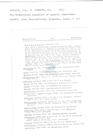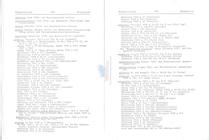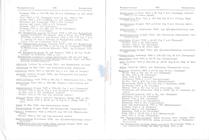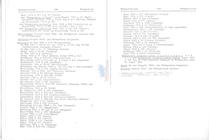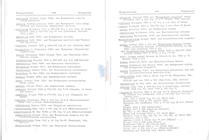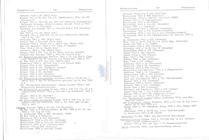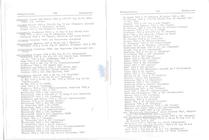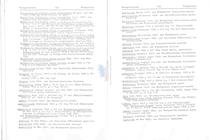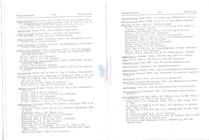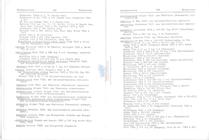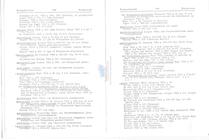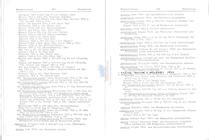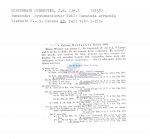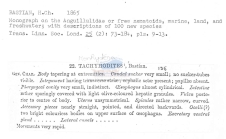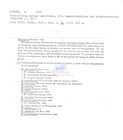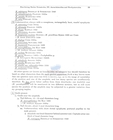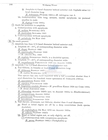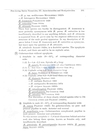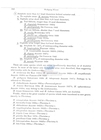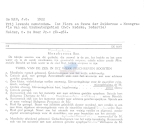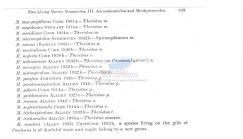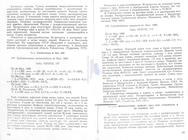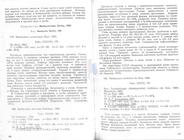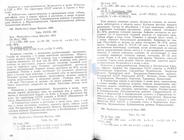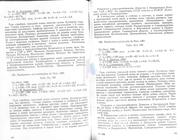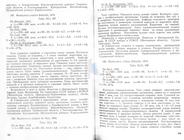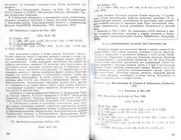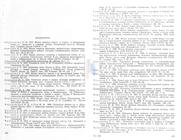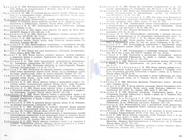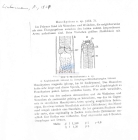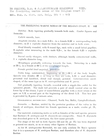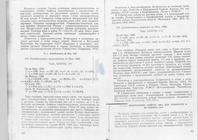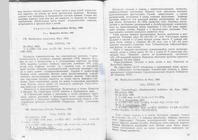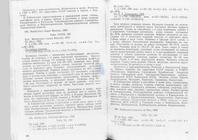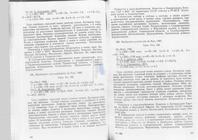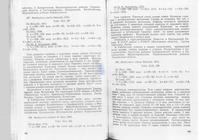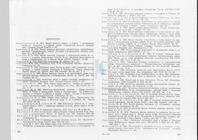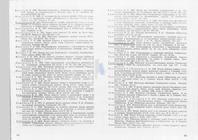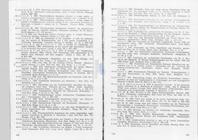WoRMS taxon details
Monhystera Bastian, 1865
2447 (urn:lsid:marinespecies.org:taxname:2447)
accepted
Genus
Helalaimus De Cillis, 1917 · unaccepted
Monohystera · unaccepted > misspelling - incorrect subsequent spelling (Monohystera used by De Man...)
Monohystera used by De Man referred to Monhystera according to Bastian 1865 and Bütschli 1873 - which is "Monhystera"
Tachyhodites Bastian, 1865 · unaccepted
- Subgenus Monhystera (Monhystrella)
- Species Monhystera fasciculata Skwarra, 1921
- Species Monhystera paludicola de Man, 1881
- Species Monhystera paramacramphis Meyl, 1954
- Species Monhystera somereni Allgén, 1952
- Species Monhystera stagnalis Bastian, 1865
- Species Monhystera acris Bastian, 1865 accepted as Theristus acer Bastian, 1865
- Species Monhystera adiecta Schulz, 1932 accepted as Daptonema adiecta (Schulz, 1932) Wieser, 1956
- Species Monhystera agilis de Man, 1880 accepted as Theristus agilis (de Man, 1880) Filipjev, 1918
- Species Monhystera ambigua Bastian, 1865 accepted as Monhystera disjuncta Bastian, 1865 accepted as Halomonhystera disjuncta (Bastian, 1865) Andrássy, 2006
- Species Monhystera ambiguoides Bütschli, 1874 accepted as Halomonhystera ambiguoides (Bütschli, 1874)
- Species Monhystera ampullocauda Paramonov, 1926 accepted as Gammarinema ampullocauda (Paramonov, 1926) Lorenzen, 1986
- Species Monhystera anophthalma Lorenzen, 1969 accepted as Monhystrella anophthalma (Lorenzen, 1969) Jacobs, 1987
- Species Monhystera anoxybiotica Jensen, 1986 accepted as Thalassomonhystera anoxybiota (Jensen, 1986) Jacobs, 1987
- Species Monhystera antarctica Cobb, 1914 accepted as Halomonhystera antarctica (Cobb, 1914) Andrássy, 2006
- Species Monhystera arcospiculum Allgén, 1947 accepted as Daptonema arcospiculum (Allgén, 1947) Wieser, 1956
- Species Monhystera attenuata Filipjev, 1922 accepted as Thalassomonhystera attenuata (Filipjev, 1922) Jacobs, 1987
- Species Monhystera australis Cobb, 1894 accepted as Geomonhystera australis (Cobb, 1894) Andrássy, 1981
- Species Monhystera barentsi Steiner, 1916 accepted as Halomonhystera uniformis (Cobb, 1914) Andrássy, 2006
- Species Monhystera bipunctata Schneider, 1906 accepted as Theristus bipunctatus (Schneider, 1906) Gerlach & Riemann, 1973
- Species Monhystera brevicollis Cobb, 1894 accepted as Theristus brevicollis (Cobb, 1894) Filipjev, 1922
- Species Monhystera bulbosa Grimm, 1876 accepted as Chromadorissa bulbosa (Grimm, 1876) Filipjev, 1918
- Species Monhystera cameroni Steiner, 1958 accepted as Halomonhystera cameroni (Steiner, 1958) Andrássy, 2006
- Species Monhystera cartaromanae Meyl, 1954 accepted as Thalassomonhystera cartaromanae (Meyl, 1954)
- Species Monhystera cephalophora de Man, 1876 accepted as Thalassomonhystera cephalophora (de Man, 1876)
- Species Monhystera chesapeakensis Timm, 1952 accepted as Daptonema chesapeakensis (Timm, 1952) Lorenzen, 1979
- Species Monhystera chitwoodi Steiner, 1958 accepted as Geomonhystera chitwoodi (Steiner, 1958) Jacobs, 1987 accepted as Halomonhystera chitwoodi (Steiner, 1958) Andrássy, 2006
- Species Monhystera collaris Filipjev, 1922 accepted as Thalassomonhystera collaris (Filipjev, 1922)
- Species Monhystera conica Filipjev, 1922 accepted as Daptonema conicum (Filipjev, 1922) Lorenzen, 1977 (unaccepted > junior objective synonym)
- Species Monhystera cuspidospiculum Allgén, 1932 accepted as Thalassomonhystera cuspidospiculum (Allgén, 1932) Jacobs, 1987
- Species Monhystera denticulata Timm, 1954 accepted as Thalassomonhystera denticulata (Timm, 1952) Jacobs, 1987
- Species Monhystera diplops Cobb, 1894 accepted as Thalassomonhystera diplops (Cobb, 1894) Jacobs, 1987
- Species Monhystera disjuncta Bastian, 1865 accepted as Halomonhystera disjuncta (Bastian, 1865) Andrássy, 2006
- Species Monhystera dubicola Hopper & Meyers, 1967 accepted as Thalassomonhystera ocellidecorus (Hopper & Meyers, 1967) Jacobs, 1987
- Species Monhystera elongata Bütschli, 1874 accepted as Ascolaimus elongatus (Bütschli, 1874) Shuurmans Stekhoven & de Coninck, 1932
- Species Monhystera filiformis Bastian, 1865 accepted as Eumonhystera filiformis (Bastian, 1865) Andrássy, 1981
- Species Monhystera filispiculum Allgén, 1932 accepted as Daptonema filispiculum (Allgén, 1932) Wieser, 1956
- Species Monhystera frigida Cobb, 1914 accepted as Daptonema frigidum (Cobb, 1914) Wieser, 1956
- Species Monhystera groenlandica Ditlevsen, 1928 accepted as Cylindrotheristus groelandicus (Ditlevsen, 1928) accepted as Daptonema groenlandicum (Ditlevsen, 1928) Lorenzen, 1977
- Species Monhystera hallensis Paetzold, 1958 accepted as Eumonhystera pseudobulbosa (Daday, 1896) Andrassy, 1981
- Species Monhystera heterospiculum Allgén, 1932 accepted as Theristus heterospiculum (Allgén, 1932) Gerlach, 1953
- Species Monhystera inaequispiculum Lorenzen, 1979 accepted as Monhystrella inaequispiculum Lorenzen, 1979
- Species Monhystera islandica De Coninck, 1943 accepted as Thalassomonhystera islandica (De Coninck, 1943) Jacobs, 1987 accepted as Halomonhystera islandica (De Coninck, 1943) Tchesunov, Portnova & van Campenhout, 2015
- Species Monhystera izhorica Filipjev, 1929 accepted as Monhystera wangi Wu & HoeppIi, 1929
- Species Monhystera karachiensis Timm, 1963 accepted as Theristus karachiensis (Timm, 1963)
- Species Monhystera lata (Cobb, 1894) Lorenzen, 1977 accepted as Daptonema lata (Cobb, 1894) Lorenzen, 1977
- Species Monhystera longicapitata Filipjev, 1922 accepted as Thalassomonhystera longicapitata (Filipjev, 1922)
- Species Monhystera longissimecaudata Kreis in Allgén, 1935 accepted as Daptonema longissimecaudatum (Kreis, 1935) Lorenzen, 1977
- Species Monhystera luisae Schuurmans Stekhoven, 1935 accepted as Thalassomonhystera luisae (Bresslau & Schuurmans Stekhoven in Schuurmans Stekhoven, 1935)
- Species Monhystera macquariensis Allgén, 1929 accepted as Paralinhomoeus macquariensis (Allgén, 1929)
- Species Monhystera magallanica Wieser, 1956 accepted as Thalassomonhystera magallanica (Wieser, 1956) Jacobs, 1987
- Species Monhystera marina Timm, 1964 accepted as Monhystrella marina Timm, 1964
- Species Monhystera microcephalon Schuurmans Stekhoven, 1942 accepted as Spiramphinema microcephalon (Schuurmans Stekhoven, 1942) Wieser, 1956
- Species Monhystera microphthalma de Man, 1880 accepted as Monhystrella microphthalma (de Man, 1880) Jacobs, 1987
- Species Monhystera multisetosa Meyl, 1955 accepted as Eumonhystera multisetosa (Meyl, 1955) Andrássy, 1981 accepted as Thalassomonhystera multisetosa (Meyl, 1955) Jacobs, 1987
- Species Monhystera natans (Bastian, 1865) Butschli, 1874 accepted as Thalassomonhystera natans (Bastian, 1865) Jacobs, 1987
- Species Monhystera normandica de Man, 1890 accepted as Daptonema normandicum (de Man, 1890) Lorenzen, 1977
- Species Monhystera norwegica Allgén, 1933 accepted as Theristus (Penzancia) norwegicus (Allgén, 1933) Wieser, 1956 accepted as Theristus norwegicus (Allgén, 1933) Wieser, 1956
- Species Monhystera ocellata Bütschli, 1874 accepted as Diplolaimella ocellata (Bütschli, 1874)
- Species Monhystera ocellidecoris Hopper & Meyers, 1967 accepted as Thalassomonhystera ocellidecorus (Hopper & Meyers, 1967) Jacobs, 1987
- Species Monhystera oistospiculum Allgén, 1932 accepted as Theristus oistospiculum (Allgén, 1932)
- Species Monhystera oxycerca de Man, 1888 accepted as Theristus oxycerca (de Man, 1888) Wieser, 1956 accepted as Daptonema oxycerca (de Man, 1888) Lorenzen, 1977
- Species Monhystera oxyuroides Schuurmans-Stekhoven, 1931 accepted as Cylindrotheristus oxyuroides (Schuurmans Stekhoven, 1931) Wieser, 1956 accepted as Daptonema oxyuroides (Schuurmans Stekhoven, 1931) accepted as Daptonema trabeculosum (Schneider, 1906) Lorenzen, 1977
- Species Monhystera pachyuris Ditlevsen, 1928 accepted as Thalassomonhystera pachyuris (Ditlevsen, 1928)
- Species Monhystera paraambigua Allgén, 1933 accepted as Halomonhystera disjuncta (Bastian, 1865) Andrássy, 2006
- Species Monhystera paraambiguoides Allgén, 1932 accepted as Halomonhystera disjuncta (Bastian, 1865) Andrássy, 2006
- Species Monhystera paradisjuncta De Coninck, 1943 accepted as Halomonhystera paradisjuncta (De Coninck, 1943) accepted as Halomonhystera disjuncta (Bastian, 1865) Andrássy, 2006
- Species Monhystera paradoxa Allgén, 1926 accepted as Eumonhystera paradoxa (Allgén, 1926)
- Species Monhystera parasimplex De Coninck, 1943 accepted as Eumonhystera parasimplex (De Coninck, 1943) Andrássy, 1981 accepted as Thalassomonhystera parasimplex (De Coninck, 1943) Jacobs, 1987
- Species Monhystera parelegantula De Coninck, 1943 accepted as Monhystrella parelegantula (De Coninck, 1943) Andrássy, 1981
- Species Monhystera parva (Bastian, 1865) Butschli, 1874 accepted as Thalassomonhystera parva (Bastian, 1865) Jacobs, 1987
- Species Monhystera polychaeta Steiner, 1915 accepted as Steineria polychaeta (Steiner, 1915) Micoletzky, 1922
- Species Monhystera praevulvata Allgén, 1932 accepted as Monhystera disjuncta Bastian, 1865 accepted as Halomonhystera disjuncta (Bastian, 1865) Andrássy, 2006
- Species Monhystera problematica Allgén, 1927 accepted as Theristus problematicus (Allgén, 1927) Wieser, 1956
- Species Monhystera pusilla Boucher & Helléouet, 1977 accepted as Thalassomonhystera pusilla (Boucher & Helléouet, 1977) Jacobs, 1987
- Species Monhystera refringens Bresslau & Schuurmans Stekhoven, 1935 accepted as Thalassomonhystera refringens (Bresslau & Schuurmans-Stekhoven, 1935) Jacobs, 1987
- Species Monhystera rotundicapitata Filipjev, 1922 accepted as Thalassomonhystera rotundicapitata (Filipjev, 1922) Jacobs, 1987 accepted as Halomonhystera rotundicapitata (Filipjev, 1922) Tchesunov, Portnova & van Campenhout, 2015
- Species Monhystera sabulicola Allgén, 1929 accepted as Thalassomonhystera sabulicola (Allgén, 1929)
- Species Monhystera septentrionalis (Cobb, 1914) accepted as Daptonema septentrionalis (Cobb, 1914)
- Species Monhystera setosa Bütschli, 1874 accepted as Theristus setosus (Bütschli, 1874) Wieser, 1956 accepted as Mesotheristus setosus (Bütschli, 1874) Wieser, 1956 accepted as Daptonema setosum (Bütschli, 1874) Lorenzen, 1977
- Species Monhystera setosissima Cobb, 1894 accepted as Steineria setosissima (Cobb, 1894) Schuurmans Stekhoven & De Coninck (1933)
- Species Monhystera signifera Paramonov, 1929 accepted as Diplolaimella signifera (Paramonov, 1929) Gerlach & Riemann, 1973
- Species Monhystera similis Bütschli, 1873 accepted as Eumonhystera similis (Bütschli, 1873) Andrássy, 1981
- Species Monhystera simplex de Man, 1880 accepted as Eumonhystera simplex (de Man, 1880) Andrássy, 1981
- Species Monhystera socialis Bütschli, 1874 accepted as Halomonhystera socialis (Bütschli, 1874) Andrássy, 2006
- Species Monhystera tasmaniensis Allgén, 1927 accepted as Thalassomonhystera tasmaniensis (Allgén, 1927) Jacobs, 1987
- Species Monhystera tenuis Schuurmans Stekhoven, 1950 accepted as Thalassomonhystera tenuis (Schuurmans Stekhoven, 1950)
- Species Monhystera tenuispiculum Ditlevsen, 1918 accepted as Daptonema tenuispiculum (Ditlevsen, 1918) Lorenzen, 1977
- Species Monhystera tobagoensis Allgén, 1947 accepted as Thalassomonhystera tobagoensis (Allgén, 1947)
- Species Monhystera trabeculosa Schneider, 1906 accepted as Daptonema trabeculosus (Schneider, 1906) accepted as Daptonema trabeculosum (Schneider, 1906) Lorenzen, 1977
- Species Monhystera trichura Allgén, 1930 accepted as Monhystrella microphthalma (de Man, 1880) Jacobs, 1987
- Species Monhystera uniformis Cobb, 1914 accepted as Halomonhystera uniformis (Cobb, 1914) Andrássy, 2006
- Species Monhystera velox Bastian, 1865 accepted as Theristus (Penzancia) velox Bastian, 1865 accepted as Penzancia velox (Bastian, 1865) de Man, 1889 accepted as Theristus velox Bastian, 1865
- Species Monhystera venusta Lorenzen, 1979 accepted as Thalassomonhystera venusta (Lorenzen, 1979) Jacobs, 1987
- Species Monhystera vivipara Allgén, 1929 accepted as Monhystera disjuncta Bastian, 1865 accepted as Halomonhystera disjuncta (Bastian, 1865) Andrássy, 2006
- Species Monhystera vulgaris de Man, 1880 accepted as Eumonhystera vulgaris (de Man, 1880) Andrássy, 1981
- Species Monhystera capitata Schuurmans Stekhoven, 1942 (uncertain > taxon inquirendum)
- Species Monhystera droebachiensis Allgén, 1931 (uncertain > taxon inquirendum)
- Species Monhystera elegantula Schuurmans Stekhoven, 1935 (uncertain > taxon inquirendum)
- Species Monhystera filicaudata Allgén, 1929 (uncertain > taxon inquirendum)
- Species Monhystera gracilicauda Schuurmans Stekhoven, 1950 (uncertain > taxon inquirendum)
- Species Monhystera heterolaima Schuurmans Stekhoven, 1950 (uncertain > taxon inquirendum)
- Species Monhystera macrolabiata Kreis, 1928 (uncertain > taxon inquirendum)
- Species Monhystera paramonovi Allgén, 1953 (uncertain > taxon inquirendum)
marine, brackish, fresh, terrestrial
Bastian, H. C. (1865). Monograph of the Anguillulidae, or Free Nematoids, Marine, Land, and Freshwater; with Descriptions of 100 New Species. <em>The Transactions of the Linnean Society of London.</em> Volume XXV. Part II:73-184.
note: Original genus description p 97 [details]
note: Original genus description p 97 [details]
Nemys eds. (2024). Nemys: World Database of Nematodes. Monhystera Bastian, 1865. Accessed through: World Register of Marine Species at: https://www.marinespecies.org/aphia.php?p=taxdetails&id=2447 on 2024-07-26
Date
action
by
2004-12-21 15:54:05Z
created
db_admin
2006-09-25 06:54:45Z
changed
Martinez, Olga
![]() The webpage text is licensed under a Creative Commons Attribution 4.0 License
The webpage text is licensed under a Creative Commons Attribution 4.0 License
original description
Bastian, H. C. (1865). Monograph of the Anguillulidae, or Free Nematoids, Marine, Land, and Freshwater; with Descriptions of 100 New Species. <em>The Transactions of the Linnean Society of London.</em> Volume XXV. Part II:73-184.
note: Original genus description p 97 [details]
original description (of Helalaimus De Cillis, 1917) Onorato-De Cillis, M. I. (1917). Nuovi generi e nuove specie di Nematodi liberi d'acqua dolce. <em>Monitore Zoologico Italiano.</em> 28(4-5): 57-62. [details]
original description (of Tachyhodites Bastian, 1865) Bastian, H. C. (1865). Monograph of the Anguillulidae, or Free Nematoids, Marine, Land, and Freshwater; with Descriptions of 100 New Species. <em>The Transactions of the Linnean Society of London.</em> Volume XXV. Part II:73-184. [details]
taxonomy source Lorenzen, S. (1979). Marine Monhysteridae (sensu stricto, Nematodes) von der südchilenischen Küste und aus den küstenfernen Sublitoral der Nordsee. <em>Studies on Neotropical Fauna and Environment.</em> 14: 203-214. [details] Available for editors [request]
[request]
taxonomy source Heip, C.; Herman, R.; Vincx, M. (1983). Subtidal meiofauna of the North Sea: A review. <em>Biol. Jb. Dodonaea.</em> 51: 116-170. (look up in IMIS) [details] Available for editors [request]
[request]
basis of record Nemaslan: Biodiversity of Antarctic Nematodes (2004). (look up in IMIS) [details]
additional source Brunel, P., L. Bosse & G. Lamarche. (1998). Catalogue of the marine invertebrates of the estuary and Gulf of St. Lawrence. <em>Canadian Special Publication of Fisheries and Aquatic Sciences, 126.</em> 405 pp. (look up in IMIS) [details] Available for editors [request]
[request]
additional source Filipjev, I. N. (1918). Free-living marine nematodes of the Sevastopol area. <em>Transactions of the Zoological Laboratory and the Sevastopol Biological Station of the Russian Academy of Sciences.</em> Series II No 4 (Issue I & II) (Translated from Russian). [details]
additional source Integrated Taxonomic Information System (ITIS). , available online at http://www.itis.gov [details]
additional source Alongi, D. M.; Sasekumar, A. (1992). Benthic Comunities. <em>Tropical Mangrove systems.</em> pp. 137-227. [details] Available for editors [request]
[request]
additional source Armenteros, M.; Vincx, M.; Decraemer, W. (2009). Cienfuegia gen. nov. (Xyalidae) and Pseudoterschellingia gen. nov. (Linhomoeidae), two new genera of free-living marine nematodes from the Caribbean Sea. <em>Journal of Natural History.</em> 43(17-18): 1067-1081. (look up in IMIS) [details] Available for editors [request]
[request]
additional source Cobb, N. A. (1894). Tricoma and other nematode genera. <em>The proceedings of the Linnean Society of New South Wales (Second Series).</em> Vol. VIII, 389-421 -With 28 plates. [details]
additional source Copley, J. T. P.; Flint, H. C.; Ferrero, T. J.; Van Dover, C. L. (2007). Diversity of meiofauna and free-living nematodes in hydrothermal vant mussel beds on the northern and southern East Pacific Rise. <em>J. Mar. Biol. Ass. U.K.</em> [details] Available for editors [request]
[request]
additional source Dando, P. R.; Austen, M. C.; Burke, Jr. R. A.; Kendall, M. A.; Kennicutt, II M. C.; Judd, A. G.; Moore, D. C.; O'Hara, S. C. M.; Schmaljohann, R.; Southward, A. J. (1991). Ecology of a North Sea pockmark with an active methane seep. <em>Marine Ecology Progress Series.</em> 70: 49-63. [details] Available for editors [request]
[request]
additional source Derycke, S.; Van Vynckt, R.; Vanaverbeke, J.; Vincx, M.; Moens, T. (2007). Colonization patterns of Nematoda on decomposing algae in the estuarine environment: community assembly and genetic structure of the dominant species Pellioditis marina. <em>Limnology and Oceanography.</em> 52(3): 992-1001. (look up in IMIS) [details] Available for editors [request]
[request]
additional source Flint, H. C.; Copley, J. T. P.; Ferrero, T. J.; Van Dover, C. L. (2006). Patterns of nematode diversity at hydrothermal vents on the East Pacific Rise. <em>Cah. Biol. Mar.</em> 47: 365-370. [details] Available for editors [request]
[request]
additional source Gaudes, A.; Sabater, S.; Vilalta, E.; Muñoz, I. (2006). The nematode community in cyanobacterial biofilms in the river Llobregat, Spain. <em>Nematology.</em> 8(6), 909-919. [details] Available for editors [request]
[request]
additional source Gerlach, S. A. (1954). Die freilebenden Nematoden der schleswig-holsteinischen Küsten. <em>Schr. naturw. Ver. Schlesw.-Holst.</em> 27: 44-69. [details] Available for editors [request]
[request]
additional source Guo, Y.; Helléouet, M.-N.; Boucher, G. (2008). Spatial patterns of meiofauna and diversity of nematode species assemblages in the Uvea lagoon (Loyalty Islands, South Pacific). <em>Journal of the Marine Biological Association of the United Kingdom.</em> 88(5), 931–940. [details] Available for editors [request]
[request]
additional source Commito, J.A. & G. Tita. (2002). Differential dispersal rates in an intertidal meiofauna assemblage. <em>Journal of Experimental Marine Biology and Ecology.</em> 268(2): 237-256. [details] Available for editors [request]
[request]
additional source Lorenzen, S. (1974). Die Nematodenfauna der sublitoralen Region der Deutschen Bucht, insbesondere im Titan-Abwassergebiet bei Helgoland. <em>Veröff. Inst. Meeresforsch. Bremerh.</em> 14: 305-327. [details] Available for editors [request]
[request]
additional source Miljutin, D. M.; Gad, G.; Miljutina, M. M.; Mokievsky, V. O.; Fonseca-Genevois, V.; Esteves, A. M. (2010). The state of knowledge on deep-sea nematode taxonomy: how many valid species are known down there?. <em>Marine Biodiversity.</em> 40(3): 143-159., available online at https://doi.org/10.1007/s12526-010-0041-4 [details] Available for editors [request]
[request]
additional source Neave, Sheffield Airey. (1939-1996). Nomenclator Zoologicus vol. 1-10 Online. <em>[Online Nomenclator Zoologicus at Checklistbank. Ubio link has gone].</em> , available online at https://www.checklistbank.org/dataset/126539/about [details]
additional source Various Authors (2000). Nematode filing cabinet of the Marine Biology Section Ugent - in combination with the NemasLan Ms-Access database (published on CD-Rom, 2000) (look up in IMIS) [details]
additional source Bunt, J. S. (1954). The soil-inhabiting nematodes of Macquarie Island. <em>Aust. J. Zool.</em> 2: 264-274. [details] Available for editors [request]
[request]
additional source Zhou, H. (2001). Effects of leaf litter addition on meiofaunal colonization of azoic sediments in a subtropical mangrove in Hong Kong. Journal of Experimental Marine Biology and Ecology, Elsevier, Amsterdam 256(1):99-121. [details] Available for editors [request]
[request]
additional source Zeppilli, D. & R. Danovaro (2009). Meiofaunal diversity and assemblage structure in a shallow-water hydrothermal vent in the Pacific Ocean. Aquatic Biology. 5(1):75-84., available online at https://doi.org/10.3354/ab00140 [details] Available for editors [request]
[request]
additional source Fonseca, G.; Decraemer, W.; Vanreusel, A. (2006). Taxonomy and species distribution of the genus Manganonema Bussau, 1993 (Nematoda: Monhysterida). <em>Cahiers de Biologie Marine.</em> 47 (2): 189-203. [details] Available for editors [request]
[request]
additional source Timm, R. W.; Ameen, M. (1960). Nematodes Associated With Commercial Crops In East Pakistan. <em>Agriculture Pakistan.</em> 11 (3) : 1-9. [details] Available for editors [request]
[request]
additional source Timm, R. W. (1966). Some Observations on the Nematode Genera Diplolaimella and Diplolaimelloides. <em>Proc. Pakist. Acad. Sci.</em> 3 (2) : 114-125. [details] Available for editors [request]
[request]
additional source Van Gaever, S.; Moodley, L.; De Beer, D.; Vanreusel, A. (2006). Meiobenthos at the Arctic Håkon Mosby Mud Volcano, with a parental-caring nematode thriving in sulphide-rich sediments. <em>Marine Ecology Progress Series.</em> 321: 143-155., available online at https://doi.org/10.3354/meps321143 [details] Available for editors [request]
[request]
additional source Van Gaever, S.; Olu, K.; Derycke, S.; Vanreusel, A. (2009). Metazoan meiofaunal communities at cold seeps along the Norwegian margin: Influence of habitat heterogeneity and evidence for connection with shallow-water habitats. <em>Deep Sea Research Part I: Oceanographic Research Papers.</em> 56(5): 772-785., available online at https://doi.org/10.1016/j.dsr.2008.12.015 [details] Available for editors [request]
[request]
additional source Van Gaever, S.; Vanreusel, A.; Hughes, J.; Bett, B.; Kiriakoulakis, K. (1999). The macro- and micro-scale patchiness of meiobenthos associated with the Darwin Mounds (north-east Atlantic). <em>Journal of the Marine Biological Association of the UK.</em> 84(3): 547-556., available online at https://doi.org/10.1017/s0025315404009555h [details] Available for editors [request]
[request]
additional source Vanreusel, A.; Van Den Bossche, I.; Thiermann, F. (1997). Free-living marine nematodes from hydrothermal sediments: similarities with communities from diverse reduced habitats. <em>Mar. Ecol. Prog. Ser.</em> 157: 207-219. [details] Available for editors [request]
[request]
additional source Venekey, V.; Fonseca-Genevois, V.; Santos, P. J. P. (2010). Biodiversity of free-living marine nematodes on the coast of Brazil: a review. <em>Zootaxa.</em> 2568: 39–66. [details] Available for editors [request]
[request]
additional source De Oliveira Pinto, T.K.,Netto, S.A., Esteves, A.M., De Castro, F.J.V., Neres, P.F. and Da Silva, M.C. (2021). Free-living freshwater nematodes from Brazil: checklist of genera and regional patterns of diversity. <em>Nematology.</em> 0 (2021) 1-14. [details] Available for editors [request]
[request]
ecology source Raes, M.; De Troch, M.; Ndaro, S. G. M.; Muthumbi, A.; Guilini, K.; Vanreusel, A. (2007). The structuring role of microhabitat type in coral degradation zones: a case study with marine nematodes from Kenya and Zanzibar. <em>Coral Reefs.</em> 26 (1): 13-126. [details] Available for editors [request]
[request]
ecology source Raes, M.; Vanreusel, A. (2006). Microhabitat type determines the composition of nematode communities associated with sediment-clogged cold-water coral framework in the Porcupine Seabight (NE Atlantic). <em>Deep-Sea Research Part I.</em> 53 (12): 880-1894. [details] Available for editors [request]
[request]
note: Original genus description p 97 [details]
original description (of Helalaimus De Cillis, 1917) Onorato-De Cillis, M. I. (1917). Nuovi generi e nuove specie di Nematodi liberi d'acqua dolce. <em>Monitore Zoologico Italiano.</em> 28(4-5): 57-62. [details]
original description (of Tachyhodites Bastian, 1865) Bastian, H. C. (1865). Monograph of the Anguillulidae, or Free Nematoids, Marine, Land, and Freshwater; with Descriptions of 100 New Species. <em>The Transactions of the Linnean Society of London.</em> Volume XXV. Part II:73-184. [details]
taxonomy source Lorenzen, S. (1979). Marine Monhysteridae (sensu stricto, Nematodes) von der südchilenischen Küste und aus den küstenfernen Sublitoral der Nordsee. <em>Studies on Neotropical Fauna and Environment.</em> 14: 203-214. [details] Available for editors
taxonomy source Heip, C.; Herman, R.; Vincx, M. (1983). Subtidal meiofauna of the North Sea: A review. <em>Biol. Jb. Dodonaea.</em> 51: 116-170. (look up in IMIS) [details] Available for editors
basis of record Nemaslan: Biodiversity of Antarctic Nematodes (2004). (look up in IMIS) [details]
additional source Brunel, P., L. Bosse & G. Lamarche. (1998). Catalogue of the marine invertebrates of the estuary and Gulf of St. Lawrence. <em>Canadian Special Publication of Fisheries and Aquatic Sciences, 126.</em> 405 pp. (look up in IMIS) [details] Available for editors
additional source Filipjev, I. N. (1918). Free-living marine nematodes of the Sevastopol area. <em>Transactions of the Zoological Laboratory and the Sevastopol Biological Station of the Russian Academy of Sciences.</em> Series II No 4 (Issue I & II) (Translated from Russian). [details]
additional source Integrated Taxonomic Information System (ITIS). , available online at http://www.itis.gov [details]
additional source Alongi, D. M.; Sasekumar, A. (1992). Benthic Comunities. <em>Tropical Mangrove systems.</em> pp. 137-227. [details] Available for editors
additional source Armenteros, M.; Vincx, M.; Decraemer, W. (2009). Cienfuegia gen. nov. (Xyalidae) and Pseudoterschellingia gen. nov. (Linhomoeidae), two new genera of free-living marine nematodes from the Caribbean Sea. <em>Journal of Natural History.</em> 43(17-18): 1067-1081. (look up in IMIS) [details] Available for editors
additional source Cobb, N. A. (1894). Tricoma and other nematode genera. <em>The proceedings of the Linnean Society of New South Wales (Second Series).</em> Vol. VIII, 389-421 -With 28 plates. [details]
additional source Copley, J. T. P.; Flint, H. C.; Ferrero, T. J.; Van Dover, C. L. (2007). Diversity of meiofauna and free-living nematodes in hydrothermal vant mussel beds on the northern and southern East Pacific Rise. <em>J. Mar. Biol. Ass. U.K.</em> [details] Available for editors
additional source Dando, P. R.; Austen, M. C.; Burke, Jr. R. A.; Kendall, M. A.; Kennicutt, II M. C.; Judd, A. G.; Moore, D. C.; O'Hara, S. C. M.; Schmaljohann, R.; Southward, A. J. (1991). Ecology of a North Sea pockmark with an active methane seep. <em>Marine Ecology Progress Series.</em> 70: 49-63. [details] Available for editors
additional source Derycke, S.; Van Vynckt, R.; Vanaverbeke, J.; Vincx, M.; Moens, T. (2007). Colonization patterns of Nematoda on decomposing algae in the estuarine environment: community assembly and genetic structure of the dominant species Pellioditis marina. <em>Limnology and Oceanography.</em> 52(3): 992-1001. (look up in IMIS) [details] Available for editors
additional source Flint, H. C.; Copley, J. T. P.; Ferrero, T. J.; Van Dover, C. L. (2006). Patterns of nematode diversity at hydrothermal vents on the East Pacific Rise. <em>Cah. Biol. Mar.</em> 47: 365-370. [details] Available for editors
additional source Gaudes, A.; Sabater, S.; Vilalta, E.; Muñoz, I. (2006). The nematode community in cyanobacterial biofilms in the river Llobregat, Spain. <em>Nematology.</em> 8(6), 909-919. [details] Available for editors
additional source Gerlach, S. A. (1954). Die freilebenden Nematoden der schleswig-holsteinischen Küsten. <em>Schr. naturw. Ver. Schlesw.-Holst.</em> 27: 44-69. [details] Available for editors
additional source Guo, Y.; Helléouet, M.-N.; Boucher, G. (2008). Spatial patterns of meiofauna and diversity of nematode species assemblages in the Uvea lagoon (Loyalty Islands, South Pacific). <em>Journal of the Marine Biological Association of the United Kingdom.</em> 88(5), 931–940. [details] Available for editors
additional source Commito, J.A. & G. Tita. (2002). Differential dispersal rates in an intertidal meiofauna assemblage. <em>Journal of Experimental Marine Biology and Ecology.</em> 268(2): 237-256. [details] Available for editors
additional source Lorenzen, S. (1974). Die Nematodenfauna der sublitoralen Region der Deutschen Bucht, insbesondere im Titan-Abwassergebiet bei Helgoland. <em>Veröff. Inst. Meeresforsch. Bremerh.</em> 14: 305-327. [details] Available for editors
additional source Miljutin, D. M.; Gad, G.; Miljutina, M. M.; Mokievsky, V. O.; Fonseca-Genevois, V.; Esteves, A. M. (2010). The state of knowledge on deep-sea nematode taxonomy: how many valid species are known down there?. <em>Marine Biodiversity.</em> 40(3): 143-159., available online at https://doi.org/10.1007/s12526-010-0041-4 [details] Available for editors
additional source Neave, Sheffield Airey. (1939-1996). Nomenclator Zoologicus vol. 1-10 Online. <em>[Online Nomenclator Zoologicus at Checklistbank. Ubio link has gone].</em> , available online at https://www.checklistbank.org/dataset/126539/about [details]
additional source Various Authors (2000). Nematode filing cabinet of the Marine Biology Section Ugent - in combination with the NemasLan Ms-Access database (published on CD-Rom, 2000) (look up in IMIS) [details]
additional source Bunt, J. S. (1954). The soil-inhabiting nematodes of Macquarie Island. <em>Aust. J. Zool.</em> 2: 264-274. [details] Available for editors
additional source Zhou, H. (2001). Effects of leaf litter addition on meiofaunal colonization of azoic sediments in a subtropical mangrove in Hong Kong. Journal of Experimental Marine Biology and Ecology, Elsevier, Amsterdam 256(1):99-121. [details] Available for editors
additional source Zeppilli, D. & R. Danovaro (2009). Meiofaunal diversity and assemblage structure in a shallow-water hydrothermal vent in the Pacific Ocean. Aquatic Biology. 5(1):75-84., available online at https://doi.org/10.3354/ab00140 [details] Available for editors
additional source Fonseca, G.; Decraemer, W.; Vanreusel, A. (2006). Taxonomy and species distribution of the genus Manganonema Bussau, 1993 (Nematoda: Monhysterida). <em>Cahiers de Biologie Marine.</em> 47 (2): 189-203. [details] Available for editors
additional source Timm, R. W.; Ameen, M. (1960). Nematodes Associated With Commercial Crops In East Pakistan. <em>Agriculture Pakistan.</em> 11 (3) : 1-9. [details] Available for editors
additional source Timm, R. W. (1966). Some Observations on the Nematode Genera Diplolaimella and Diplolaimelloides. <em>Proc. Pakist. Acad. Sci.</em> 3 (2) : 114-125. [details] Available for editors
additional source Van Gaever, S.; Moodley, L.; De Beer, D.; Vanreusel, A. (2006). Meiobenthos at the Arctic Håkon Mosby Mud Volcano, with a parental-caring nematode thriving in sulphide-rich sediments. <em>Marine Ecology Progress Series.</em> 321: 143-155., available online at https://doi.org/10.3354/meps321143 [details] Available for editors
additional source Van Gaever, S.; Olu, K.; Derycke, S.; Vanreusel, A. (2009). Metazoan meiofaunal communities at cold seeps along the Norwegian margin: Influence of habitat heterogeneity and evidence for connection with shallow-water habitats. <em>Deep Sea Research Part I: Oceanographic Research Papers.</em> 56(5): 772-785., available online at https://doi.org/10.1016/j.dsr.2008.12.015 [details] Available for editors
additional source Van Gaever, S.; Vanreusel, A.; Hughes, J.; Bett, B.; Kiriakoulakis, K. (1999). The macro- and micro-scale patchiness of meiobenthos associated with the Darwin Mounds (north-east Atlantic). <em>Journal of the Marine Biological Association of the UK.</em> 84(3): 547-556., available online at https://doi.org/10.1017/s0025315404009555h [details] Available for editors
additional source Vanreusel, A.; Van Den Bossche, I.; Thiermann, F. (1997). Free-living marine nematodes from hydrothermal sediments: similarities with communities from diverse reduced habitats. <em>Mar. Ecol. Prog. Ser.</em> 157: 207-219. [details] Available for editors
additional source Venekey, V.; Fonseca-Genevois, V.; Santos, P. J. P. (2010). Biodiversity of free-living marine nematodes on the coast of Brazil: a review. <em>Zootaxa.</em> 2568: 39–66. [details] Available for editors
additional source De Oliveira Pinto, T.K.,Netto, S.A., Esteves, A.M., De Castro, F.J.V., Neres, P.F. and Da Silva, M.C. (2021). Free-living freshwater nematodes from Brazil: checklist of genera and regional patterns of diversity. <em>Nematology.</em> 0 (2021) 1-14. [details] Available for editors
ecology source Raes, M.; De Troch, M.; Ndaro, S. G. M.; Muthumbi, A.; Guilini, K.; Vanreusel, A. (2007). The structuring role of microhabitat type in coral degradation zones: a case study with marine nematodes from Kenya and Zanzibar. <em>Coral Reefs.</em> 26 (1): 13-126. [details] Available for editors
ecology source Raes, M.; Vanreusel, A. (2006). Microhabitat type determines the composition of nematode communities associated with sediment-clogged cold-water coral framework in the Porcupine Seabight (NE Atlantic). <em>Deep-Sea Research Part I.</em> 53 (12): 880-1894. [details] Available for editors
 Present
Present  Inaccurate
Inaccurate  Introduced: alien
Introduced: alien  Containing type locality
Containing type locality


